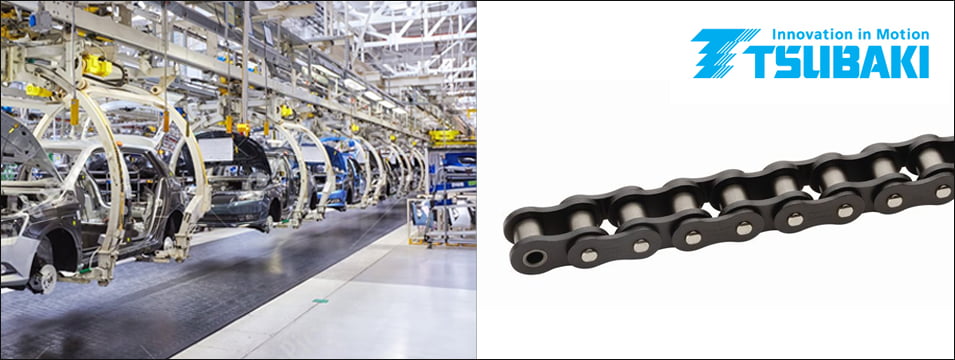Tsubaki chain solutions help a large automotive manufacturer extend the overall operation life of the chain in its assembly plant: cutting maintenance costs, reducing downtime and minimising the cost of replacement chain.
Why chain should not be considered a commodity
Automotive assembly plants are high-pressure environments, where downtime costs thousands of dollars a minute. Despite the huge costs that poor reliability generates, many manufacturers still consider the chain that drives the conveyors as a commodity product. And so base their buying decisions on price rather than performance. This creates a false economy, as buying correctly specified chain may last many times longer than the budget option. Whilst also improving the efficiency of the production line.
Automotive production demands
Automotive plants are generally expected to operate continuously with only occasional opportunities for planned maintenance throughout the year. In most cases, the car parts are moving constantly through the assembly process on overhead conveyors, taking them from one workstation to the next.
The conveyor systems that transport the vehicle body parts through the factory represent a vital part of the production flow. Should the conveyor chain break, or malfunction in any way, then a large proportion of the production line will come to a standstill. Without ample backup, this standstill can quickly spread through to the other production processes from sub-assembly to cabin fit-out, paint spraying and function testing. It can also disrupt goods inwards, dispatch and just about every other activity on site
It is perhaps surprising then, that conveyor chain is often viewed as a commodity product, rather than an engineered component. This is a common approach that is based on a false premise that all chain offers similar service life, so value can only be found at the point of purchase. The reality is that specialist chains can often survive several times longer than conventional chain, particularly in heavy duty applications.
Success story
In this case, a large automotive assembly plant found that it was having to replace its conveyor chain at least once every 12 months. The problem was made worse by the fact that maintenance was scheduled quarterly, so the chain could only be lubricated every 3 months. During this time the chain became stiff and difficult to articulate and contamination build up in the chain was causing wear. The chain would typically break inside of 12 months, therefore in order to prevent unscheduled downtime the chain was being replaced every third quarter.
The plant’s managers were keen to look for ways to improve chain management and thereby increase productivity. They invited chain experts Tsubaki to suggest an alternative solution.
Tsubaki solution
It was soon established that the OE chain in use was not suited to the heavy-duty operation and Tsubaki suggested that a better quality chain would offer a longer working life. However, to add value to the production line, the new chain would need to offer a demonstrably lower Total Cost of Ownership (TCO). Tsubaki recommended its maintenance-free, Lambda series of self-lubricated chain. Eliminatiing the need for manual lubrication while extending the overall operation life of the chain: cutting maintenance costs, reducing downtime and minimising the cost of replacement chain.
The net result of the switch to Tsubaki’s Lambda chain in the conveyor system continues to operate reliably for in excess of 2 years – more than doubling the service life of the OE chain. This means that the plant is spending less on chain each year, while also saving on maintenance costs and lost production.




